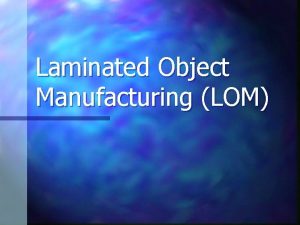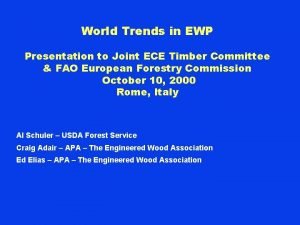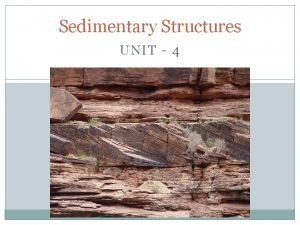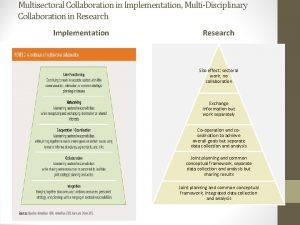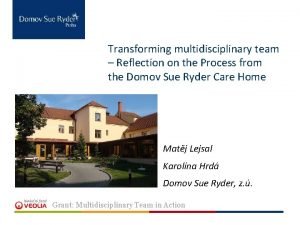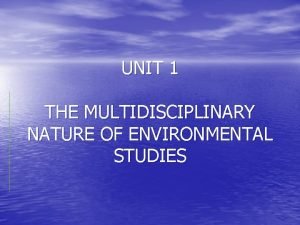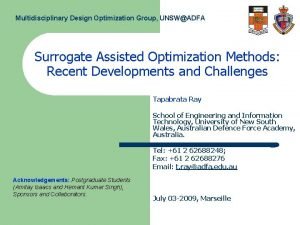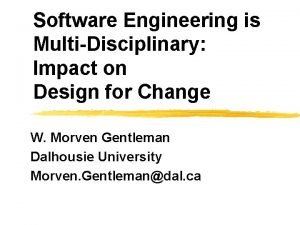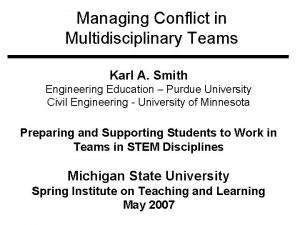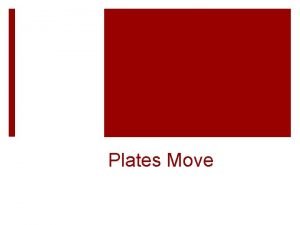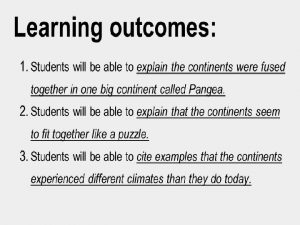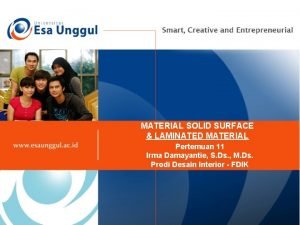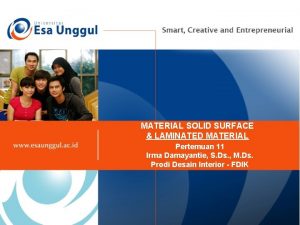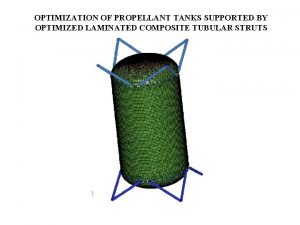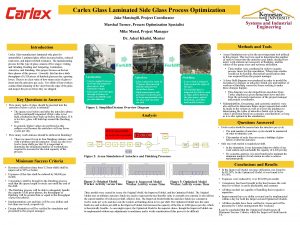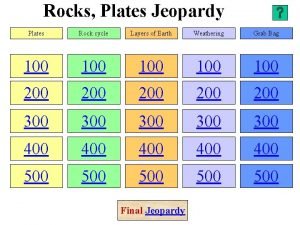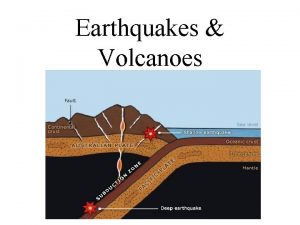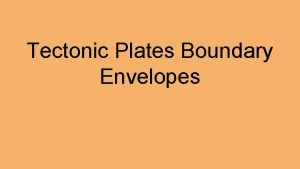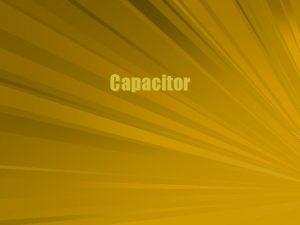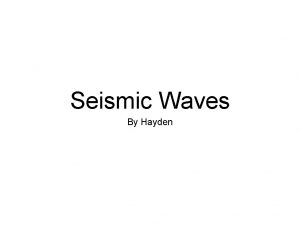Multidisciplinary Free Material Optimization for Laminated Plates and



















- Slides: 19

Multidisciplinary Free Material Optimization for Laminated Plates and Shells Alemseged G. Weldeyesus, Ph. D student Mathias Stolpe, Senior Researcher

Free Material Optimization (FMO) FMO is a one of the different approaches to structural optimization. In FMO, • the design variable is the full material tensor, • can vary freely at each point of the design domain, • necessary condition for physical attainability is the only requirement. M. P. Bendsøe, J. M. Guedes, R. B. Haber, P. Pedersen, and J. E. Taylor. An analytical model to predict optimal material properties in the context of optimal structural design. J. Appl. Mech. Trans. ASME, 61: 930– 937, 1994. M. Kočvara and M. Stingl. Free material optimization for stress constraints. Structural and Multidisciplinary Optimization, 33: 323 -335, 2007. M. Kočvara, M. Stingl, and J. Zowe. Free material optimization: Recent progress. Optimization, 57(1): 79– 100, 2008. 2 DTU Wind Energy, Technical University of Denmark 18 September

Optimal solution • Solution to FMO yields optimal distribution of the material as well as optimal local material properties. • The obtained design can be considered as an ultimately best structure. • Conceptual, since it is difficult (or actually impossible) to manufacture a structure such that its property varies at each point of the design. • FMO can be used to generate benchmarks and to propose novel ideas for new design situations. 3 DTU Wind Energy, Technical University of Denmark 18 September

The FMO problem formulation (solids) Mechanical assumptions • static loads, • linear elasticity, • anisotropic material. The basic minimum compliance problem(Discrete) 2 D, 3 D structures Constraints on local stresses • • Highly nonlinear involving matrix variables. • Adding such constraints destroys suitable problem properties, e. g. convexity. 4 DTU Wind Energy, Technical University of Denmark 18 September

Goals • Propose FMO model for laminated plates and shells. (Such models are not available today) • Develop special purpose optimization method that can efficiently solve FMO problems. (FMO problems lead to large-scale nonlinear SDP problems) 5 DTU Wind Energy, Technical University of Denmark 18 September

FMO for laminated plates and shells Based on FSDT • (C, D ), fixed within a layer in the thickness direction. • Slightly violates the idea of FMO. 6 DTU Wind Energy, Technical University of Denmark 18 September

FMO for laminated plates and shells contd… Minimum compliance problem 7 DTU Wind Energy, Technical University of Denmark 18 September

Stress constraints • Linear stress variation across the thickness within a layer. • Two stress evaluations in each layer (at the top and lower surfaces) over each finite element to capture stress extremities. 8 DTU Wind Energy, Technical University of Denmark 18 September

Optimization method • Primal-dual interior point method (second-order method). • Combines standard known interior point methods for nonlinear programmings & linear SDPs. 9 DTU Wind Energy, Technical University of Denmark 18 September

Optimization method contd… FMO problems can be represented by Introducing slack variables and barrier paramter , the associated barrier problem is We solve problem (BP) for a sequence of barrier parameter k 0. 10 DTU Wind Energy, Technical University of Denmark 18 September

Numerical results 4 layers Optimal density distribution Design domain, bc and forces • # FEs 20, 000. • No distinction between layers. • # 160, 000 matrix inequalities. • Similar to 2 D results. • # 720, 000 design variables. • No deformation out of the midsurface. • No material for D. 11 DTU Wind Energy, Technical University of Denmark • # 52 iterations. 18 September

Numerical results … 8 layers Optimal density distribution Design domain, bc and forces • 4 load-case. • # FEs 10, 000. • Symmetric laminate. • # 160, 000 matrix inequalities. • High material distribution on top and • # 720, 000 design variables. bottom layers, implies sandwich structures. ( similar results in DMO) 12 • # 25 iterations. DTU Wind Energy, Technical University of Denmark 18 September

Numerical results contd… • Curved surfaces • single layer • # FEs 80, 000. Design domain, bc and forces Optimal density distribution • # 160, 000 matrix inequalities. • # 720, 000 design variables. • # 54 iterations. • # FEs 40, 000. • # 80, 000 matrix inequalities. • # 360, 000 design variables. 13 DTU Wind Energy, Technical University of Denmark • # 51 iterations. 18 September

Numerical results contd… Stress-constrained FMO problems Design domain, bc and forces Optimal density Optimal stress distribution norms Without stress constraints • # FEs 7, 500. • # 7, 500 matrix inequalities. • # 45, 000 design variables. • # 7, 500 stress constraints. 14 With stress constraints DTU Wind Energy, Technical University of Denmark 18 September

Numerical results contd… Without stress constraints With stress constraints Optimal principal stresses Without stress constraints # iterations compliance 15 30 1. 8951 DTU Wind Energy, Technical University of Denmark With stress constraints , 60% 85 1. 9281 18 September

Numerical results contd… 8 layers Design domain, bc and forces Optimal density distribution of the top 4 layers Without stress constraints With stress constraints • # FEs 2, 500. • # 40, 000 matrix inequalities. • # 180, 000 design variables. • # 40, 000 stress constraints. 16 Optimal density distribution – no such a significant difference DTU Wind Energy, Technical University of Denmark 18 September

Numerical results contd… Optimal stress norms at the upper and lower surfaces of the first top four layers Without stress constraints With stress constraints Upper Lower Without stress constraints # iterations compliance 17 47 5. 4771 DTU Wind Energy, Technical University of Denmark With stress constraints, 30% 115 5. 5624 18 September

Conclusions • The developed optimization method solves FMO problems in a reasonable number of iterations. • Number of iterations is almost independent to problem size. • More number of iterations is required for solving the stress constrained problems (but expected). • FMO has been extended to optimal design of laminated structures. • The change of material properties plays main role in reducing high stresses in FMO. • Reduction of high stresses is achieved at a small increase in compliance. 18 DTU Wind Energy, Technical University of Denmark 18 September

Thank you for your attention ! 20 DTU Wind Energy, Technical University of Denmark 18 September
 My plates pyramid tectonic plates
My plates pyramid tectonic plates Helisys inc
Helisys inc Types of laminated dough
Types of laminated dough Laminated dough
Laminated dough Pin mike
Pin mike Laminated veneer lumber market trends
Laminated veneer lumber market trends Laminated transformer core
Laminated transformer core What does cross bedding indicate
What does cross bedding indicate Interdisciplinary example
Interdisciplinary example Multisectoral and multidisciplinary
Multisectoral and multidisciplinary Multidisciplinary team pros and cons
Multidisciplinary team pros and cons Multidisciplinary nature of environmental studies;
Multidisciplinary nature of environmental studies; Multidisciplinary
Multidisciplinary Multidisciplinary vs interdisciplinary
Multidisciplinary vs interdisciplinary Sunderlal bahuguna quotes malayalam
Sunderlal bahuguna quotes malayalam Multidisciplinary engineering definition
Multidisciplinary engineering definition Conflict in multidisciplinary teams
Conflict in multidisciplinary teams Interdisciplinary multidisciplinary transdisciplinary
Interdisciplinary multidisciplinary transdisciplinary Multidisciplinary studies epcc
Multidisciplinary studies epcc Geometric tolerance
Geometric tolerance

